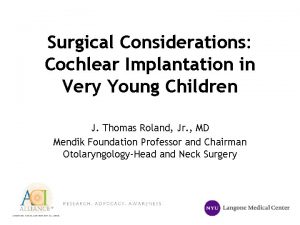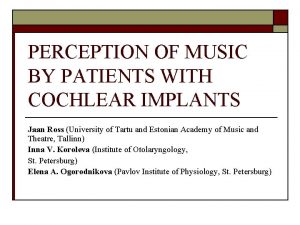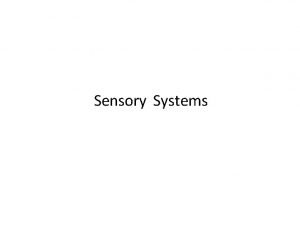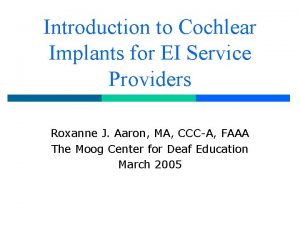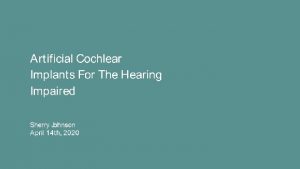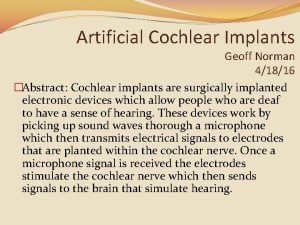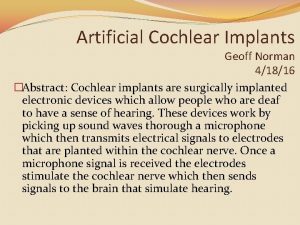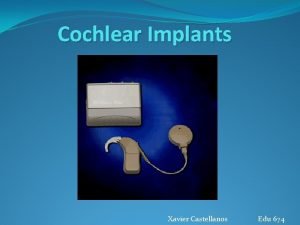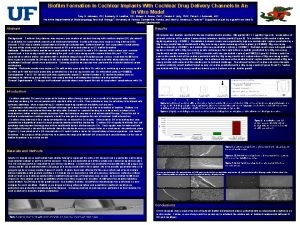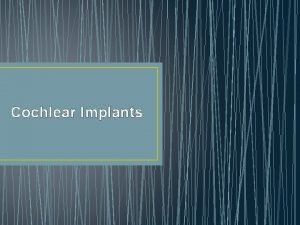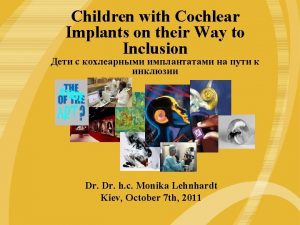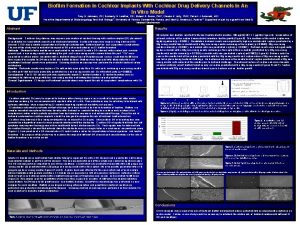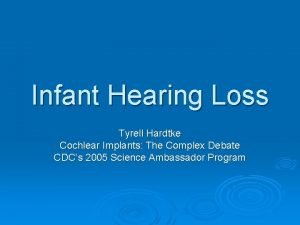Artificial Cochlear Implants For The Hearing Impaired Sensors













- Slides: 13

Artificial Cochlear Implants For The Hearing Impaired, Sensors and Transducers By Peter Spears 4/12/2017

Cochlear Implants: Introduction How cochlear implants function What goes into the implants What a transducer does


What goes into the implants A microphone or transducer to change the sound signal to an electrical signal External speech processor Implantable electrode stimulator unit Power transfer unit

How it works 1. The microphone amplifies the sound and sends it via the normal hearing pathway 2. Simultaneously, the processor converts the frequency to digital information which is sent to the implant. 3. The implant sends the electrical signals down the electrode to the cochlea. 4. The hearing nerve fibres pick up the signals and send them to the brain, giving the sensation of sound.

The speech processor captures the signals with the aid of microphone and ADC. Then it stores the digitized samples in memory for processing. The captured signal is decomposed into sub bands using the DFT (Discrete Fourier Transform) core. The DFT bins are grouped in accordance with the frequency allocated as per the CIS (Cochlear Implant System) scheme and the summation of the grouped DFT bins decides the corresponding electrode’s excitation amplitude.

In order to evaluate the quality of the speech signal stimulated by the electrodes, one can tap the electrode signals to drive a speech synthesizer/DAC unit to reconstruct the speech signal. Using a pair of inductively coupled coils, wireless transfer of power and data needed by the stimulator unit is carried out. One coil is placed behind the ear and the other one inside the human skin. The stimulator unit implanted in the inner ear excites the electrode with the amplitude determined by the speech processor.

Transducers and microphones Dynamic Electret Condeser Ribbon Piezo-electric Crystal

How a dynamic sound transducer works The microphone converts the sound waves into an electrical signal by inducing an emf through Faraday’s law of Electromagnetic Induction. The output voltage of the signal from the coil is proportional to the pressure of the sound wave acting upon the diaphragm. Because the coil is a low impedance inductor, the output voltage is very low so there must be some sort of pre-amplification of the signal. http: //www. electronics-tutorials. ws/io/io_8. html

In the future MEMS are making it possible to eliminate external parts of cochlear implants MEMS must be able to function in a corrosive, high salinity aqueous medium MEMS must find viable non-toxic materials Further developments in the semiconductor and micromechanics industries translate into implantable devices As of now, maintaining functionality is difficult due to high humidity and corrosiveness of the environment

Summary and conclusions CIS utilize transducers, sensors, and DFT. CIS are becoming more and more viable due to research in MEMS. In order for MEMS to be used within CIS, there must be further research in non-toxic materials that can withstand a corrosive environment.

References Progress in VLSI Design and Test: 16 th International Symposium on VSLI By Hafizur Rahaman, Sanatan Chattopadhyay, Santanu Chattopadhyay http: //www. electronics-tutorials. ws/io/io_8. html http: //www. cochlear. com/wps/wcm/connect/in/home/discover/cochlearimplants/how-it-works https: //www. ncbi. nlm. nih. gov/pubmed/9445853 https: //www. researchgate. net/publication/273397594_A_Fully. Implantable_Cochlear_Implant_So. C_With_Piezoelectric_Middle. Ear_Sensor_and_Arbitrary_Waveform_Neural_Stimulation Implantable Sensor Systems for Medical Applications by Andreas Inmann, Diana Hodgins http: //spectrum. ieee. org/tech-talk/biomedical/bionics/middle-ear-memsmicrophone-could-restore-hearing

Key points Transducers convert sound signals into electrical signals Piezoelectrics are used within many transducers MEMS are making cochlear implants a more viable option Cochlear implants make use of Fourier transforms to send electrical impulses to the cochlea MEMS must be able to withstand corrosive environments in the future to be used in CIS





